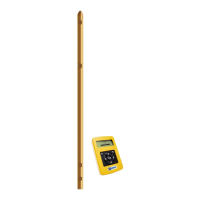MANUAL – REFLEX EZ-TRAC™ | 15
Occasionally drilling tools may wear and leave small traces of steel
on the hole wall. You are unlikely to know about this, but it may upset
your magnetic readings.
5.2.2 Man-made interference from outside the hole
Below is a selection of the more common causes of fabricated
interference:
• The drill rig itself
• Rock bolts or reinforcement mesh
• Nearby mine or tunnel workings and plant
• Piles or ground anchors
• Underground services such as pipes, cables
• Tools or equipment in another borehole
• Electrical power lines
5.2.3 Natural magnetism
Magnetite, phyrrotite and titanium oxides are all naturally magnetic
minerals. If you have cored through them, their presence should be
obvious. It will be more difficult to detect them if you drill full hole and
log cuttings. If cuttings or core are only analysed (assayed) after hole
completion, you may not know about geomagnetism at the time of
survey.
These minerals may still affect the survey if the hole has passed
close to them without there being any evidence in core or cuttings.
The other natural danger is secondary remnant magnetisation. This
takes place in rocks that are not naturally (primary) magnetic when
they are formed; but at a later date, for a number of reasons, acquire
an induced magnetisation. Some rocks are more “susceptible’ to this
than others. Use of a borehole susceptibility meter will indicate which
rocks are more, or less, susceptible; but it will not tell you which ones
might have upset your magnetic readings.
Secondary magnetization can affect all lithologies including
sedimentary materials.
5.3 Identify interference
The net result of any form of in-hole magnetic disturbance, natural or
man-made, is azimuth error. As coordinate calculations are based on
azimuth readings, these values will also be erroneous. You will not be
able to tell whether it is your hole or magnetic north that has been
deviated.
However,
REFLEX™
magnetic instruments provide you with
information that will assist you to interpret the survey data. This, when
combined with other geological, mineralogical and drilling data,
enables you to make the best possible decisions about the true
course of your holes.

